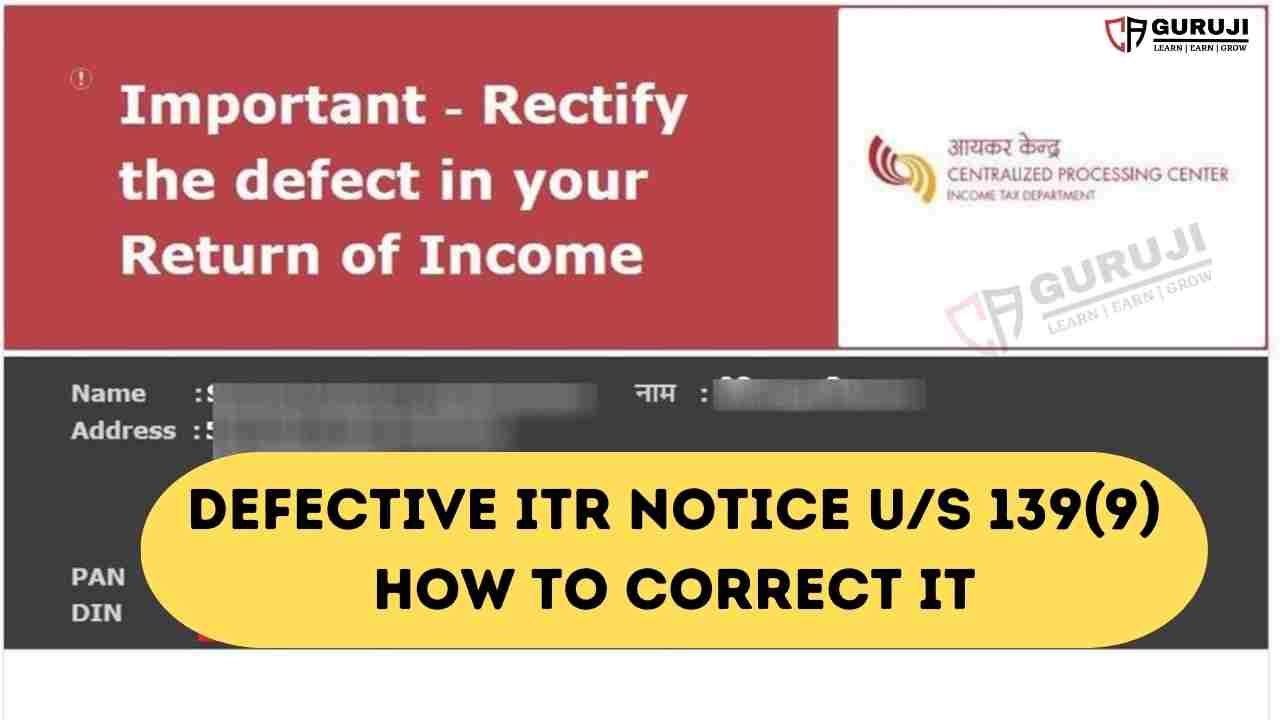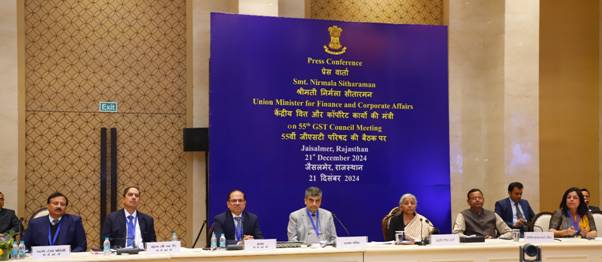Income Tax Return filing is a one time exercise every year for all persons earning income above the basic exemption limit. After filing ITR you may take sigh of relief but your task never ends here you should keep on eye on each email you receive after ITR filing on your registered email id from Income tax department as it may contain ITR intimation or ITR notice, in many cases person got Defective ITR notice u/s 139(9) due to mistakes in ITR after filing Income Tax Return and now they want to know what to do and how to rectify this
What is a Defective Return?
The tax authority sends out a defective return notice when they find mistakes or inconsistencies in your ITR. These mistakes might involve missing or conflicting information, errors in calculations, or Choosing Wrong ITR form, Mismatch in 26AS and AIS and other issues. The purpose of this notice is to prompt taxpayers to correct these errors and make sure that their tax return provides precise and complete information.
A defective return notice is issued under Section 139(9) via an email to your registered email ID. You can also access the same on the income tax e-filing portal.
How Will I Receive Notice u/s 139(9)?
The IT Department will issue the notice u/s 139(9) to your email ID registered with the income tax department. The subject of the email will be ‘Communication under section 139(9) for PAN AWZXXXXXXX for the Assessment Year 2024-25’.
What is the Password for 139(9) Notice?
The defective return notice is attached in the email and password protected. The password to open defective return notice u/s 139(9) is PAN in lowercase followed by date of birth in DDMMYYYY format. Example: if your PAN is MNOPQ1212C and your date of birth is 12/10/1987, the password would be: mnopq1212c12101987.
Time Limit to Respond to Defective Notice
If you receive a defective return notice, you must respond within 15 days of receiving the notice. If the response is not filed within 15 days or the extended days allowed, the original return filed is treated as an invalid return. Consequently, your refund will also not be processed, if any.
Situations in Which Defective Return Notice Will Be Issued
The Assessing Officer may consider the following reasons, errors, or omissions while issuing a defective return notice under section 139(9):
- Incomplete Income Tax Return (ITR): If the ITR lacks necessary details in its annexures, statements, or mandatory columns, such as income from all sources are not mentioned, etc.
- Choosing Wrong ITR forms
- Mismatch of income in 26AS, AIS and ITR
- Missing Tax Information: If taxes have been paid but their details are omitted in the ITR, including information about TDS, TCS, advance tax, or self-assessment tax.
- TDS and Income Mismatch: TDS is claimed but corresponding income is not offered for tax in the ITR.Example: If you have earned interest income from term deposits and tax has been deducted by the bank, both interest income and tax deducted should be reported in the ITR. However, while filing a return through Cleartax, all your income details will be auto-populated from the income tax department, and there is also an option to upload 26AS which will help in preventing such discrepancies right from the start.
- Bookkeeping Issues: Incomplete or non-submission of mandated books of accounts, such as trading accounts, Profit and Loss accounts, Balance sheets, and others may lead to defective return notice.
- Income Tax Audit Concerns: If an audit is required to be done under section 44AB, the complete audit report, including profit and loss account, Balance sheet, and auditors report, should be submitted. In the absence of these documents or submission of an incomplete audit report, you may invite a defective return notice.
- Cost Audit Non-compliance: Failure to submit ‘Cost Audit’ details as required by the Companies Act, 2013, can lead to a defective return notice.
- Presumptive Taxation Inaccuracies: In cases of presumptive taxation, providing inaccurate computation of presumptive income, non-disclosure of relevant details, or mismatched gross receipts can trigger a defective return notice.Example: For instance, gross receipts not mentioned in the Profit and Loss account, or the amount mentioned is more than Rs. 2 crore in ITR 4, will lead to a defective return notice.
- Tax Payment Discrepancies: If taxes are partially paid or the paid amount doesn’t align with the tax liability in the ITR, a defective return notice may be issued.
- Incorrect Details in ITR: Filing an ITR with incorrect details regarding turnover, income limits, or inappropriate reporting for a specific head of income can lead to a defective return notice.
- Mismatch in the Name: When the name mentioned in the ITR does not match the name on the PAN card.
How to Respond to Defective Return Notice u/s 139(9)?
If the Assessing Officer considers the return to be defective, then a notice will be sent to the taxpayer. The taxpayer will have 15 days time to respond to the notice.
- Revise your return addressing the defects pointed out by the Income Tax Department within 15 days.
- If you are unable to complete these revisions within the given timeframe, you have the option to seek an extension.
- If the defect is not rectified within a period of 15 days or the extended days allowed, your return may be treated as an invalid return. This could potentially lead to consequences like interest, penalty, non-carry forward of losses and forfeiture of specific exemptions.
Steps in case you receive Notice of Defective ITR:
Step 1: Check the Reason for Defective Notice.
An income tax return (ITR) may be marked defective for various reasons. Say you have received a defective notice because there is a mismatch between Form 26AS and your ITR. Download Form 26AS from the IT portal and check if you have earned any income on which tax has been deducted, for example:
- interest income from term deposits;
- dividend income; or
- any other income.
Ideally, you should have reported both your income and the tax deducted in your ITR. However, if you claim only TDS but miss out on reporting the income, you may receive a defective notice.
Step 2: Steps on How to Respond to Defective Notice u/s 139(9) on Income Tax Portal
Log in on the e-filing website with your user ID (PAN/Aadhaar number) and password.

Click on ‘Pending Actions’ and then select ‘E-proceedings’.

Click on the ‘View Notices’. Here, you can view the notice and submit your response. After reading the notice, click on ‘Submit Response’.


you can see Notice from here also read carefully

You can see the error description to understand the defect and its probable resolution is also mentioned alongside. If you agree with the error details, select the ‘Agree’ option and ‘Offline utility’ as the mode of response.

If you are agree then you have to prepare the correct Return first using Offline utility or Excel utility in which you have to select Filled in response to section u/s 139(9), add details as required and file complete return with correction of error etc. and generate JSON

After generation of JSON reply to defective notice, click on agree button, here you will get the option to upload JSON, complete the process.

If you disagree with the defect, you can proceed by selecting the ‘Disagree’ option. You will also have to give reasons for disagreement in the text box provided.

Check the box ‘Response cannot be modified after submission’ and then click on ‘Submit‘.
Now click on the ‘Proceed to e-verify‘ button to e-verify your response for defective notice u/s 139(9). You can e-verify by any of the methods.
You will see a confirmation message with an acknowledgment number on the screen upon successful uploading.
FAQ:
What is a Defective Return?
A return may be treated as defective on account of incomplete or inconsistent information in the return or in the schedules or for any other reason.
2. How do I know if my return is defective?
If your return is found defective, the Income Tax Department will send you a defective notice under section 139(9) of the Income Tax Act via an email on your registered email id or post and the same can be viewed by logging in on the e-filing portal.
3. Can I update or withdraw my response after submitting the response on the e-Filing portal?
No, you cannot update or withdraw your response once submitted.
4. Can I authorise another person to respond to my Defective Notice?
Yes, you can authorize another person to respond to the defective notice u/s 139(9).
5. Can I correct the defect in the ITR Form online?
Yes, you can submit the response by online correcting the defect in the ITR Form.
6. What is the time limit within which I can respond to a Defective Notice sent by Income Tax Department?
If your return is found defective, you will get 15 days of time from the date of receiving the notice or as the time duration specified in the notice to rectify the defect in the return filed by you. However, you may seek Adjournment and request for an extension.
7. What if I don’t respond to a Defective Notice?
If you fail to respond to the defective notice within stipulated period then your return may be treated as invalid and therefore consequences such as penalty, interest, non carry forward of losses, loss of specific exemptions may occur,as the case may be in accordance with the Income Tax Act.
8. I have been notified about defective returns u/s 139(9). Can I file the return again as fresh return for that assessment year?
Yes, You can either file the return as a fresh/ revised return incase the time provided for filing the return in a particular assessment year has not lapsed or alternatively you can also choose to respond to Notice u/s139. However, once the time provided for filing the return for a particular assessment year has lapsed, you will not be able file the return as a fresh/ revised return and you will have to respond to Notice u/s 139(9). If you are unable to respond to the notice, the return will be treated as invalid or not filed for that assessment year.
9. What are some of the common errors that make a return Defective?
Some of the common errors that make a return defective are as follows:
- Credit for TDS has been claimed but the corresponding receipts/income has been omitted to be offered for taxation,
- The gross receipts shown in Form 26AS, on which credit for TDS has been claimed, are higher than the total of the receipts shown under all heads of income, in the return of income.
- “Gross Total Income” and all the heads of income is entered as “nil or 0” but tax liability has been computed and paid.
- Name of taxpayer in ITR does not match with the “Name” as per the PAN data base.
- Taxpayer having income under the head “Profits and gains of Business or Profession” but has not filled Balance Sheet and Profit and Loss Account.
Visit www.cagurujiclasses.com for practical courses












Hi, I have received Defective notice 139(9) for wrong ITR. After the notice I filled revised return under 139(5). Now, when I am uploading that JSON file to Defective Response it getting warning.
As i understand it is bcoz of 139(5), where i should filled under 139(9). Can you pleas guide what should i do in this case?
Should i resubmit revised under 139(9)? or I ignore to Response to Deflective ITR.